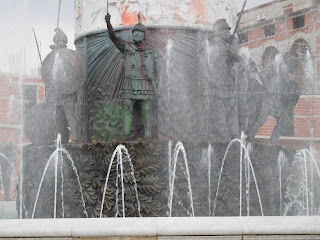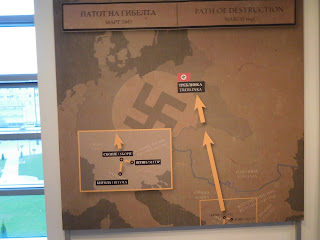We arrived at our hostel in Skopje, Macedonia's capital, in the early afternoon afer getting a bus from Prizren in Kosovo. To use the term 'hostel' was a bit misleading as there were only two rooms and it had no common area. We have been so used to having either the hostel or hotel room be in the center of the city, this one caught us offguard as it was certainly away from the middle of things. It was more than a bit of a schlep into or out from the city center each time but we got used to it. Our host, Ljupco, was exceedingly helpful and our room/apartment was a very good size and those factors by far made up for the somewhat inferior location.
Walking into town we both thought this building could compete with the National
Library in Pristina, Kosovo’s capital, for the world’s ugliest building
contest!
I can't tell you how very surprising it was seeing so many double decker buses and we wondered why they were here in Skopje
of all places.
The first of what would be a gazillion statues in Skopje! This one was in front of the
Right across the street was a pretty big park with a few dozen more, I kid you not! I think it was called the Park of the Woman Warrior, according to our hostel owner, but we saw no statue like that. This one, however, sure looked neat whatever it was!
The Fallen Heroes of Macedonia monument. The English subtitles on the sign were missing so
it was hard to really get a sense of the memorial’s significance. It seemed clear
that Macedonia's war dead of WWII were being commemorated.
Unfortunately though, recent political unrest has lead to this and other monuments in the park being hit with balloons filled with paint. It is sad when politics intrude on the memory of those who made the ultimate sacrifice.
The statue represented self-sacrifice in the form of Prometheus, who stole fire from the gods. The statue of Prometheus was first naked, but, after complaints by women's organizations, he was given underwear. It was the same story with the statue in Belgrade, Serbia, a few weeks back in the trip.
There was just one monument after another.
Protests in the form of paintballs. The words 'Never More' were stenciled on this one.
This powerful memorial in the corner of the park honored the ten Macedonian soldiers and police officers who were ambushed and killed near the end of the 2001 armed conflict with ethnic Albanian rebels.
According to Steven’s ipad, this was called the Gate of
Macedonia but we later learned it was called the Triumphal Arch. It sure looked like a massive paintball 'game' had exploded over the arch that also resembled Paris' Arc de Triomphe.
Just inside the gate were inscriptions by Mother Teresa who
was born in Skopje . There will be more about her in my next post.
Once we walked through the gate/arch, we were in for a big surprise. The buildings on either side were grand and opulent. The massive square just beyond them was undergoing a massive reconstruction. We could only imagine what it would be like when it’s completed. To say we were stupefied by what we saw as we entered the square is an understatement. The huge Alexander the Great Fountain was the focal point of the square.
More evidence of paintballs sadly having run amok:
Zachary: Notice the gorgeous Marriott Hotel in the lovely square. Too bad we didn't try and use your family discount there! Bet it would have been a lot nicer than the Hostel Atlantik.
One of the more disturbing sights was of these very young boys using juice bottles as drumsticks to beg for
money the entire length of the magnificent footbridge.
The boys' parents or guardians watched from one of the nearby fountains.
More incredible buildings - it was just mindboggling as they went on and on and on.
Big parts of Skopje
have been destroyed several times in the last 500 years: In 1555 and 1963 by major
earthquakes and in 1689 when Skopje
was set on fire by the Italian-Austrian General Piccolomini on his retreat
during an outbreak of the plague. Some say he set fire to Skopje
to eradicate the plague; others say it was revenge for the Ottoman invasion of Vienna
in 1683.
A pirate ship - whatever is next?!
A pirate ship - whatever is next?!
As we entered the Museum, we saw this montage of faces. Some stayed static while others
changed. It set the tone as a remembrance of ordinary people who were
killed.
Railroad car used to transport Jews to the extermination camps:
The first display was about the Jewish Cemetery Memorial
Park
Monastir/Bitola served as the Jews' cemetery. In March of 1943,
the ‘horrible gust of the Holocaust forever wiped out the last generation of
Jews from this town as they disappeared into the ashes of Treblinka.’ What a very moving and poignant description of just one example of the Nazis' policies as they attempted to eradicate all the Jews.
Suspended from the central core of the building was the arresting Memorial Sculpture. It was visible from every floor and differed from every angle viewed. It was comprised of 7,144 unique beaded strands to symbolize the individuality of the Holocaust victims. 'No two strands are identical and yet together they form a tapestry, joining together as one image of struggle and survival.'
The Museum had an interesting panel on the traditional role of Jewish women in Macedonia. Women provided health care, oversaw hygiene, took care of the numerous small children and of the elderly and were solely responsible for their.daughters' education. Married women were not expected to leave the courtyards often. A popular saying warned 'Women should act as if they have a broken leg!'
Life in the courtyards: Most Jewish households shared courtyards where almost all their neighbors were also Jewish. Courtyards were the center of life especially in the sprning and summer. Residents fetched water from public fountains and did laundry in the courtyards. Until modern times, indoor kitchens were a rariety. Jewish women cooked and cleaned in communal ovens.
The women created a vibrant network of mutual support, helping each other in times of mutual need. The courtyard was for them what the marketplace was for men: a place to relax, socialize, compete and air rivalries. For girls it was their only school - a school of life
As we all know from our history books, the devastation of
WWII began with the 1939 invasion of Poland by Germany and the move westward in
1940. In April of 1941, it reached Yugoslavia
which was conquered and dismembered by its allies, according to the information
presented at the museum.
In each region, the Jews’ fate depended on the anti-Jewish
policies implemented by the pro-German occupiers and local collaborators.
Ultimately, over 80% of the Jewish population or 60,000 Jews were slaughtered
in Yugoslavia .
Following its conquest of Macedonia ,
Germany turned
control over to Bulgaria
in April of 1941. Macedonian Jews immediately became subject to Bulgarian
anti-Jewish decrees. Beginning in
early 1942, the Bulgarian occupation
authorities in Bitola demanded all Jewish
heads of households enter their names and addresses in a registry along with
their photos. This record is unique in the annals of Holocaust history as this
is more than likely the only one of its kind ever produced.
The poster with the Jewish star indicated a Jewish residence. The other said 'No admittance to Jews.' These signs were common all over Macedonia.Young Jews, often without family responsibilities, widely supported armed resistance. Most members of the Zionist Youth Organization became partisans. Some 1,500 Jews died fighting to liberate Yugoslavia.
'Liberation: Confronting the Catastrophe: Macedonians celebrated liberation in November of 1944. For Jews, loss overshadowed joy. The major Jewish communities, as well as smaller clusters, were gone. Rubble replaced synagogues, schools and entire Jewish neighborhoods. Of Macedonia's nearly 8,000 Jews, only 350 survived. Yet they struggled to rebuild. In December of 1944, survivors created the National Liberation Council of Macedonian Jews and rebuilt the synagogue in Skopje.
From 1948-1952, Yugoslavia allowed 7,500 Jews - more than one in every two Yugoslav Jews - to resettle in newly independent Israel.
The burning bush installation over all three floors was a supreme
artistic touch that tried to transport and remind the viewer of one of the most
significant elements in Judaism.
I found the Museum to be a very significant exhibition of the history and
fate of Jewish people in
We then walked over to St. Demetrius Orthodox Church which was just
a few steps away. It was very dark inside so it was difficult to take photos to show the
superb frescoes.
The Church's adjoining Bell Tower:
Another fountain and lots more statues of course:
We strolled next around the old Turkish neighborhood of Carsija. The old bazaar has been a center for trade and merchants since as early as the 12th century and nowadays it represents an iconic heritage site for the city. It is a vivid representation of the country's past and its inheritance from the
It was just enchanting walking around the almost deserted cobblestoned streets as it was getting late.
I was surprised but happy to see the recycling sign. You know a city is
doing well when it considers the importance of dealing responsibly with its trash.
How beautiful seeing the Millenium Cross in the distance overlooking the city at the top of Vodno Mountain! It was built to serve as a memorial of 2,000 years of Christianity in Macedonia and the world. Construction of the cross began in 2002 and was funded by the Macedonian Orthodox Church, the government and donations from Macedonians from all over the world.
The city looked even more magical at night as we walked back to the hostel!
We just grabbed a bite to eat in the food court in the large, ultra modern mall on the way back to our apartment as it had a grocery store too. Adam: Thought of you when we saw this shoe store. Turns out it's a chain as we saw others later throughout Skopje.
Wilma: Thought of you as there was a cart with a huge variety of baklava ready for hungry customers. I am sure you would have loved trying some!After only being in Skopje for half a day, we figured it must be among Europe's most entertaining and ecletic small capital cities. While the government's huge construction spree has sparked controversy in recent years, Skopje's abundance of statues, monuments, museums and other structures had me snapping photos like never before!
Posted from Tirana, Albania on September 29th, 2016.





























































































Who knew Adam would be a popular Macedonian name?!?
ReplyDelete